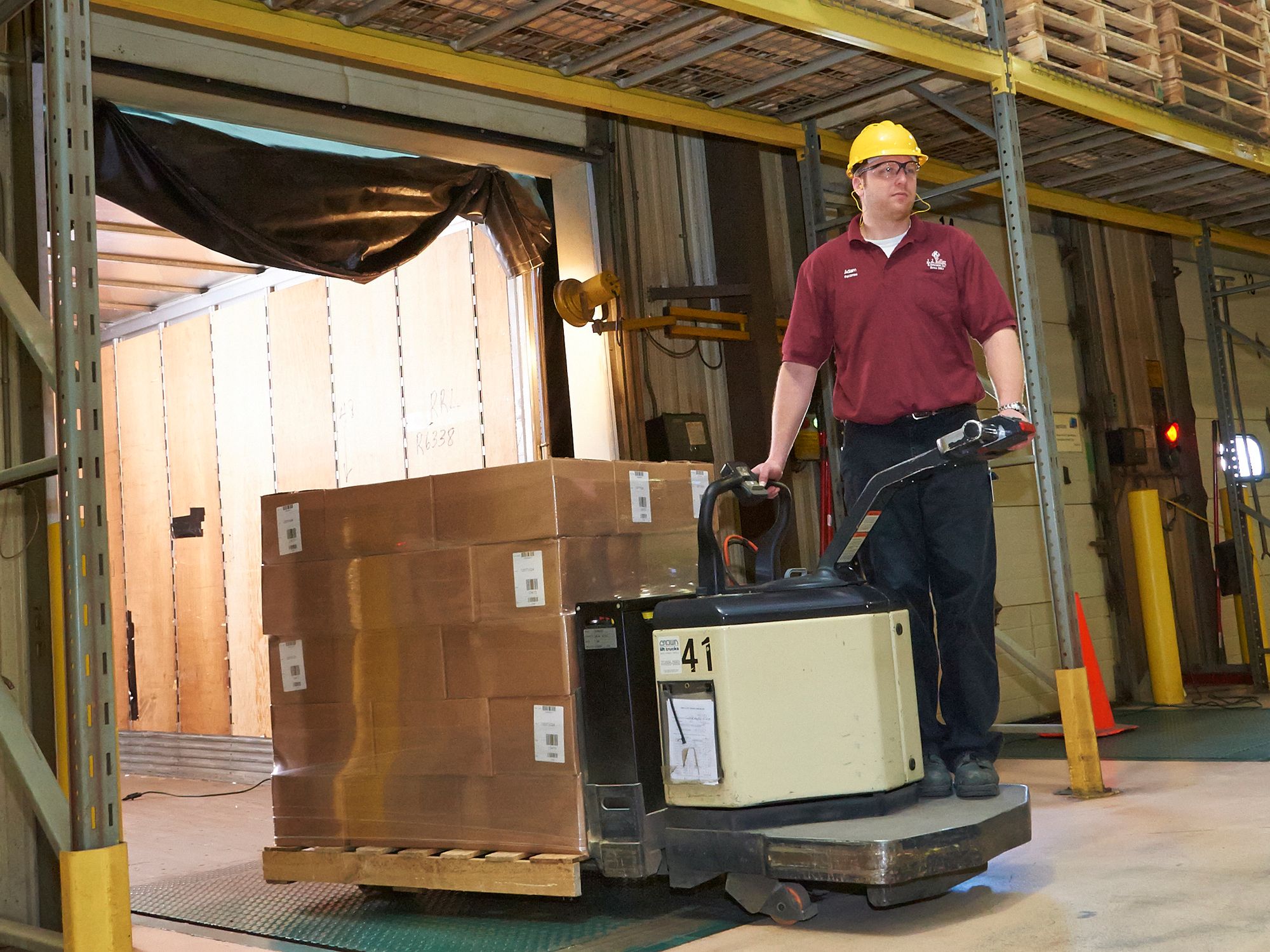Pallet jacks (powered/motorized)

Powered/motorized pallet jacks are a common fixture in many industries and workplaces. They allow workers to quickly move heavy loads from one location to another, go in tight spaces that forklifts cannot, and conveniently make frequent stops to “pick” materials. While they may seem like a straightforward and harmless piece of machinery, the fact is powered pallet jacks can pose deadly hazards if not operated properly and by trained individuals. In fact, OSHA requires training of powered pallet jack operators under the same requirement as that for forklift operators—the 1910.178 Powered Industrial Truck regulation.
Action steps
- Certify operator training. Just because an operator is trained/certified to operate a forklift does not make them automatically certified to operate a powered pallet jack: training must be specific to each “type” of equipment.
- Select appropriate and approved equipment.Make sure name plates, markings, and warning labels are in place and adequate.
- Use only approved equipment for the particular area.
- Change, charge, and store batteries properly.
- Provide emergency response equipment for flushing and neutralizing spilled electrolyte, for fire protection, for protecting charging apparatus from damage by trucks, and for adequate ventilation for dispersal of fumes from gassing batteries.
- Set brakes of highway trucks and chock wheels when they are boarded with powered industrial trucks.
- Ensure proper operation and loading.
- Inspect trucks daily before each shift.
- Perform appropriate maintenance.
- Remove damaged equipment from use.
- Become familiar with and follow the manufacturer’s operation, safety, and maintenance instructions.
Training action plans
Training must consist of a combination of formal instruction (e.g., lecture, discussion, interactive computer learning, video tape, written material), practical training (demonstrations performed by the trainer and practical exercises performed by the trainee), and evaluation of the operator’s performance in the workplace.Training should cover the following topics:
- Safe operation
- Truck-related topics:
- operating instructions, warnings, and precautions for the types of pallet jacks the operator will be authorized to operate
- differences between the pallet jack and the automobile
- controls and instrumentation: where they are located, what they do, and how they work
- engine or motor operation
- steering and maneuvering
- visibility (including restrictions due to loading)
- fork and attachment adaptation, operation, and use limitations
- capacity
- stability
- any inspection and maintenance that the operator will be required to perform
- refueling and/or charging and recharging of batteries
- operating limitations
- any other operating instructions, warnings, or precautions listed in the operator’s manual
- Workplace-related topics:
- surface conditions where the equipment will be operated
- composition of loads to be carried and load stability
- load manipulation
- pedestrian traffic in areas where the equipment will be operated
- hazardous (classified) locations where the vehicle will be operated
- ramps and other sloped surfaces that could affect stability
Refresher training must be given when needed and employers must perform a triennial evaluation of forklift operators.
Tips
- Be careful of rear-end swing when turning corners. The rear end will swing wide to the outside of a turn when operating with the load end leading. Extra clearance may be needed to avoid striking racking, pedestrians, etc.
- Check the data plate to determine the grades/inclines the equipment can operate safely on. When walking with a pallet truck with or without a load, the forks should be pointed downgrade, regardless of direction of travel. On walkie/riders, when in the riding position travel with loaded trucks with the load upgrade; when empty with the load end downgrade.
- Always look in the direction of travel. Pallet jack operators have had fingers and other parts crushed between the pallet jack and racks and walls—in particular, when backing out.
- Do not ride powered pallet jacks. Only walkie/riders have a platform for riding.
- Do not allow passengers on pallet jacks or walkie/riders.
- Inspect truck trailers before entering. Pallet jacks are heavier than they look and combined with a load can fall through a worn floor.
Checklist
These checklists will help ensure all pallet jacks are functioning safely and being used correctly.
Pallet jack operations
- Are the pallet jacks in your facility correctly designated for your type of operation (based on atmosphere, hazards of materials handled, etc.)?
- Are the brakes on each industrial truck capable of bringing the vehicle to a complete and safe stop when fully loaded?
Training
- Are only trained personnel allowed to operate pallet jacks?
- Have you documented what methods you use to train operators?
Maintenance and inspection
- Are your pallet jacks inspected before being placed in service? Inspections should be at least daily, or after each shift, if used around the clock.
- Are adequate inspection and maintenance records kept?
- Are all industrial trucks not in safe operating condition removed from service?
- Does the inspection include all items recommended by the manufacturer? At minimum, these typically include:
- Forks
- Brakes
- Quick disconnect, if equipped
- Hand guard
- Controls
- Battery and battery securing mechanism
- Warning labels/data plates
- Hydraulics (including fluid leaks)
- Horn
- Belly button, if equipped
